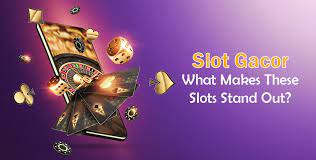
Slot machines, often called “one-armed bandits,” have become slot gacor synonymous with the thrill and unpredictability of gambling. Whether in bustling casinos or online platforms, these machines captivate millions of players with their flashing lights, tempting sounds, and promises of huge payouts. But behind the fun lies a fascinating world of design, mathematics, psychology, and technology that makes slot machines one of the most popular games in the gambling world.
A Brief History of Slots
The first slot machine was invented in 1895 by Charles Fey, a mechanic from San Francisco. Known as the “Liberty Bell,” it was a simple mechanical device with three reels and five symbols: horseshoes, diamonds, spades, hearts, and a bell. The machine worked by using a spring-loaded mechanism to spin the reels, and when a player hit a winning combination, coins would pour out. Over the years, the game evolved from mechanical machines to digital versions, with the addition of bonus features, wild symbols, and progressive jackpots.
How Slot Machines Work: The Mechanics and Technology
Modern slot machines, especially those found in online casinos, are incredibly sophisticated. While mechanical slots rely on gears and springs, digital slots use random number generators (RNGs) to determine the outcome of each spin. The RNG produces a sequence of numbers, and each number corresponds to a position on the virtual reels. Once the spin button is pressed, the RNG ensures that the result is entirely random and fair, eliminating any chance of manipulation.
In addition to the RNG, modern slots incorporate complex algorithms that manage the payout percentage, volatility, and return-to-player (RTP) rates. The RTP rate indicates the percentage of money wagered on a slot that is paid back to players over time. For example, a slot with a 95% RTP will, theoretically, return $95 for every $100 wagered. However, this is just a statistical average, and individual outcomes can vary dramatically in the short term.
The Psychology of Slot Machines
One of the key reasons why slot machines are so addictive is the psychology behind them. Casinos and game developers carefully design these machines to keep players engaged and encourage prolonged play. A few of the psychological tactics include:
- The Near Miss Effect: When players come close to winning (but don’t), it can be more frustrating than losing entirely. However, this feeling can also trigger them to continue playing, believing that a win is imminent. Many slots are designed to create these near-miss scenarios, which can keep players spinning the reels longer.
- Variable Rewards: Slot machines use a system of intermittent rewards, where wins are unpredictable. This type of reward system is linked to the brain’s release of dopamine, the “feel-good” neurotransmitter, making players feel exhilarated every time they hit a win, no matter how small. The randomness of the rewards helps to maintain the excitement.
- Sensory Stimulation: The lights, sounds, and flashing colors of a slot machine are engineered to heighten emotional responses. The sudden burst of noise after a win, or the dramatic pause before the reels stop, creates anticipation and a heightened sense of involvement.
Types of Slot Machines
Slots come in a wide variety of themes and styles, catering to all types of players. Some of the most popular types of slot machines include:
- Classic Slots: These are inspired by the original machines from the 19th century and typically feature three reels and fewer paylines. They are simple, with traditional symbols like fruits, sevens, and bars.
- Video Slots: These slots have five or more reels and are packed with exciting graphics, animations, and bonus features. Video slots often follow a storyline or theme, such as mythology, adventure, or popular movies.
- Progressive Slots: Progressive slots are connected across multiple machines or casinos, and a portion of every wager contributes to a shared jackpot. This creates the possibility of enormous payouts, often reaching millions of dollars. Popular progressive slots include titles like Mega Moolah and The Dark Knight.
- 3D Slots: These are a newer innovation, providing an immersive gaming experience with stunning visuals, elaborate storylines, and dynamic animations that make players feel as though they are part of the game.
The Future of Slot Machines
The world of slot machines is constantly evolving, with technology driving innovation. One exciting development is the integration of virtual reality (VR) and augmented reality (AR) into the gaming experience. These technologies promise to take slot machines to a whole new level by creating fully immersive environments where players can interact with the game in a 360-degree space.
Additionally, the rise of mobile gaming has made slots more accessible than ever. With smartphones and tablets, players can spin the reels from anywhere in the world, providing greater convenience and flexibility. Developers are also focusing on improving the social aspect of slot games, integrating multiplayer features, chat rooms, and leaderboards to enhance the overall experience.
Conclusion: The Allure of Slots
Slot machines are a staple of the gambling industry for good reason. They offer players an exciting and unpredictable way to potentially win big, all while being simple enough for anyone to enjoy. Whether you’re playing at a brick-and-mortar casino or spinning the reels online, the magic of slot machines lies in their ability to combine technology, psychology, and design to deliver an immersive and thrilling gaming experience. As technology continues to advance, the future of slot machines holds even more potential for innovation and excitement. So, next time you pull the lever or tap the screen, take a moment to appreciate the complexity behind the game – and, of course, enjoy the ride!